page 1
(The Study of Threes)
http://threesology.org
The following illustration is a generalized portrayal of the three theories concerning the shape of the Universe:
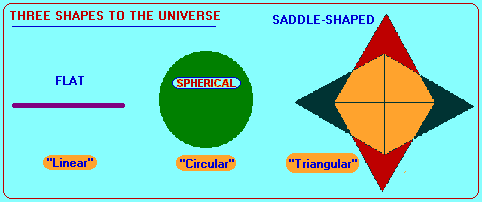
For those of you who can not visually fold two of the triangles upward and two of them downward, I provide the next illustration which gives a representation of the saddle-shape configuration:
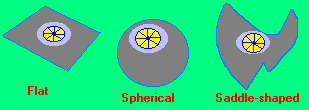
There are different ways of visualizing the saddle-shaped image. It simply depends on what shape of saddle you have in mind at the time and from what perspective you are drawing it. On one occasion I saw it as two (or more) triangles overlapping at their tips (apexes) with the base parts folding in a contour-like fashion. One could even consider a saddle-shape to be square or rectangular if a blanket type of saddle is thought of. And if one imagines no saddle on a horse ridden by a naked person such as Lady Godiva, well you will have to use your own imagination for that description. No less, we can think of a flat universe in terms of a linear image that is not in the shape of a square as the above picture portrays in an example thereof. This is true also of the spherical shape in that we might visualize an ellipsoid form.
Nonetheless, there are three theories representing the shape of the universe with respect to our current form of biological-based understanding of Physics and Astronomy. And for those of you who care to think of String Theory as being a different type of idea altogether, then we have a 3 to 1 ratio formula for theoretical considerations of the Universe's design. If we were to combine all of them into a singular idea, we might find that the Universe also exhibits a 1~ 2~ 3 (overlapping) maturational development in which all the above theories are somewhat representative of transitional stages in the "evolution" of the Universe.
Because all things in life appear to follow a similar plan from the simple to the more complex, and that we frequently find such plans represented by ideas, notions, theories, laws, assumptions, hypothesis, etc., within the context of a description involving a pattern-of-three formulation; the fact that our world is made up of three dimensions (i.e., length~ width~ depth), leads us to suspect that the Universe may also proceed along a similar 3-patterned pathway from the simple to the more complex. This pathway may very well have begun at a 1-dimension type of Universe that progressed into a 2-dimensional construction prior to arriving at our present 3-dimensional Universe.
Another representation of these three forms can be seen in the following image:
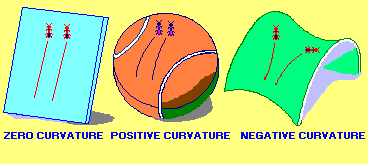
--- The Geometry of the Universe ---
http://csep10.phys.utk.edu/astr162/lect/cosmology/geometry.html
As you can see, the saddle-shaped form takes on still another look from the previous two examples; the shape of the "saddle" has a different shape depending on the perspective you use.
Here is another view of the 3 different ideas concerning the shape of the Universe:
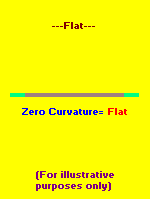 |
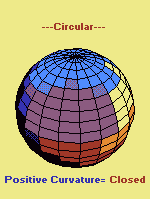 |
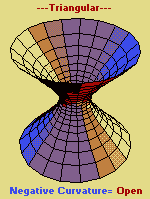 |
Image and information source:
http://www.superstringtheory.com/cosmo/cosmo21.html
The three ideas concerning the shape of the Universe may represent the hint of a progressive developmental sequence along a 1-dimensional~ 2-dimensional~ 3- dimensional pathway with stages of growth that have overlapped. And not unlike the remnants of transitional stages of developmental progression found in biological life forms on the genetic, cellular, and overall body structures, these three theories of the Universe's design may be an indication of humanity's initial attempts to grasp such a similarity of function. This does not in anyway suggest that these three theories are actual representations of the development of the Universe along this sequence, but that they are an approximation formulated by a human brain that frequently portrays its views with a pattern-of-three formula. While this formula may be presented in various guises of language, symbols, and contexts, whereby the structure is overlooked due to more emotionally-laden concerns cited by individual preferences of significance, its recurring presence suggests itself as being an expression of a developmental process in and of itself. Thus the pattern-of-three is just another vague symbol of an underlying developmental process along a 1~ 2~ 3 sequence.
In short, life appears to follow along a 3-patterned path from the simple to a more complex structure. In many instances, we can find indications of earlier forms which provides for further argument in favor of a developmental trend frequently referred to as growth, maturity, and in some cases, it is called Evolution.
Some people are particularly troubled by the word Evolution when it is tied to the views of Charles Darwin. They think their views of the Universe are absolute because they believe in an absolute God that does not change... even though their own views about a God do change. Yet they deny that the word "change" equates with Evolution. They may even say they are simply "adapting" to changing social circumstances, but that this adaptation to changing environmental conditions in terms of the social realm has nothing to do with Evolution in any sense of the word when applied to circumstances involving developmental biology or of a species. |
For those of you who are not bothered by the word "Evolution," let us suggest that the Universe evolves in a fashion that influences galaxies, solar systems, and individual planets to give some indication of this evolutionary trek. And these forces will in turn influence geologic, genetic, and other biological processes. And these biological processes assist in influencing the human mind to fashion similar forms characteristic of its processes, which can influence other human minds to portray it as well...in their own way, in their own time, using that medium of expression that they are best able to use under varying circumstances. You may want to consider that the human brain has the capacity, at birth, to develop along a pathway which enables it to reconstruct these basic patterns of the Universe.
Instead of using the labels Flat, Spherical, and Saddle-shaped, I use Linea ~ Circular ~ Triangular. These three labels, I feel, are roughly the same and will help to increase your understanding of the avenues of exploration you will encounter on this page. For some readers, it is even more helpful if I use the more common words of Line, Circle, and Triangle. In any respect, we are presented with 3 theories of the Universe. It is of interest to note that the progressive development of ideas related to the shape of the Earth are:
The Earth was once viewed as being Flat. (Or, at least there is the idea of a flat world that has been passed around whether or not a large percentage of the population believe in it.)
Many people of today view the Earth as round.
There is a growing number of people who realize the shape of the Earth is in a type of triangular (pear) shape called a triaxial ellipsoid.
Whereas the progress in the evolution of the Earth's shape is the result in an explosion of knowledge, the progression of the Universe is said to have been the result of an explosion commonly referred to as the "Big Bang." However, it is necessary to consider whether the explosion (implosion?) occurred at a single point in time, 2 points in time, or 3 points in time, and whether the spread was in 1 direction, 2 directions, or spread out in 3 (many) directions. No less, we may want to further consider whether or not a Big Bang explosion progresses along its own 1~ 2~ 3 sequence from the simple to the more complex:
The following illustration is a whimsical representation of these three options of direction for the explosion (although one can easily think in terms of implosion):
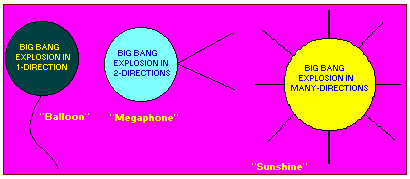
The use of a balloon with string to represent a 1-direction explosion.
A megaphone to represent a simplistic 2-direction explosion (though some may want to argue that a megaphone is multi-directional... it is (1) spread out in a (2) single direction).
And a Sun with rays to represent the 3rd option of "many" (or 3) directions.
These three not only present the possibility that the images of the Universe's beginning may be impressed upon biological materials and expressed by humans with symbols characteristic of an individual's age whether young or old; but also illustrate that such symbols can provide a clue as to the occurrence of a developmental progression. Humans are very much a primitive organism. And like a plant that will "express" its environmental experiences in a way conducive to its level of primitive construction, humanity do so likewise... despite the ego-tistical claims of sophistication.
While the balloon image is easily recognized as an item related to young children, the megaphone sometimes is not readily seen as an item associated with adolescence/young adulthood, until the association between megaphones, cheerleaders, and sporting events is made. And though the Sun image is being associated with later adult life, it is a symbol that is frequently illustrated on children's drawings. Most people might consider this representation due to a child's experience of the Sun's presence on a day to day basis, but it is not generally considered that the Sun itself, as well as children's portrayals thereof, are re-creations of some previous event in the Universe that influenced the image's construction. In other words, in this sense, not only is a drawing of a Sun with rays to be imagined as an image of some earlier event, but such items as the burner trays on top of stoves, spoked wheels, star fishes, etc..., may also be symbolic representations thereof. |
In the sense of development, the balloon represents an early "childhood" stage, the megaphone represents a later "adolescent" stage, and the sunshine image represents a later stage, such as adults working in the sun, getting a tan, or simply trying to stay out of the Sun for fear of over-exposure to cancer- causing ultraviolet rays. Old people tend to stay out of the Sun as much as possible and lighter skinned people are cautioned about the necessity of taking precautions against the Sun's harmful rays, such as by using sunglasses, skin ointments, appropriate garments, etc...
Which brings to mind for some people the consideration that "old age" (in terms of developmental longevity), and lighter skin, in terms of the anthropological progression of humanity, may be synonymous in the sense of lighter skin representing a type of later-born element of (more advanced) development that is superior to other skin colors under particular environmental conditions which enhances survival of the individual experiencing those conditions. Under other conditions, less lighter skin colors are more favorable for survival. Albinos may thus represent the ability of humanity to progress even further, given the appropriate environmental circumstances such as may come in the future if humanity travels deep into space where the effects of sunlight might be less. |
With the fear of the ozone breaking down due largely to humanity's burning of petroleum-based fuels, along with the gradual expansion of the Sun and the slowing rate of the Earth's rotation, levels of skin pigmentation may very well become a topic of (increased) considerable interest in the years ahead.
However, current reports of the increasing depletion of the ozone layer are being interpreted as "non-absolute 100% certainties" by government officials who then declare that no policies will be made which affect businesses whose operations are said to be necessary for the economic stability of the country, yet are responsible for depleting the ozone layer. The only change to be seen will be an increased charge for various energy sources which is argued to be necessary to curb human usage and bring about a beneficial change in arresting a depletion of the ozone that they initially argue against when confronted with scientific data, thereby ensuring government-backed businesses will reap increased profits but will not provide more jobs for the public sector. |
Current interests in the ozone often obscures the realization that its chemical symbol is O3. When viewed as an isolated acknowledgment, most people are quick to dismiss this comment as an abstruse reference to other information that has no relevance for them. However, when placed along-side tens of hundreds of other examples related to an underlying cognitive orientation, it no longer remains at a distance from the reader, but becomes an additional link to a pattern of frequent referencing related to an underlying 1~ 2~ 3 maturational development sequence.
Changes in the Earth's environment have been occurring for billions of years. Some of these changes are found in geological (sediment) stratifications which tell of the behavior of the ocean tides some 3 billion years ago. The information gives us a rough approximation of the Moon's cycle which was about 20 days long as compared to the common notion of a 30 day cycle. In effect, the Moon's cycle was about one-third faster than it is today, if interpretations of the billions-of-years-old sediment sites are correct. In our attempts to refute or substantiate these claims, we might want to search for confirmation or denial in other time-keeping mechanisms such as fossils. In fact, the marine fossil record does give an indication the Earth's rate of rotation some 3 billion years ago was approximately one-third faster than it is today. This would be about 18 hours long in comparison to our present 24 hour rate.
While some researchers might want to jump for joy that their work might be substantiated by others working in another field of study, the more cautious observer considers the possibility that the only thing that may have been confirmed is that a similar level of testing methodology was employed. They remain skeptics not only about the method of testing and who did the testing where and when, but also that there needs to be a third type of confirmation. They require additional confirmation because there are some reports that the Earth's rate of rotation was considerably faster, which would conflict with the estimated rate of spin for the Moon during the same time period. If they are different, why are they different? To use a type of analogy, could it be that one or more estimations are not even in the stadium much less the ball field? And what does this suggest for the testing methods being used where and when by whomever on what?
Both of these (tides & fossils) examples provide us with two different interpretations of how fast the Earth was spinning billions of years ago. A third interpretation is based upon the idea that the Earth initially had been spinning much faster when the solar system came into being after the "Big Bang" of the Universe. Since many of these earliest of Cosmological events occurred long before life is assumed to have evolved on planet Earth, it may be considered that these earliest events did not become impressed upon our earliest of biological beginnings unless there is an underlying Universal constant of repeating cycles that all Matter is privy to on the sub-atomic level which may or may not find some symbolic manifestation in an overt biological expression that is easily recognized.
If the planetary fragments of the Big Bang did not spin fast when first being catapulted from the explosion, this bespeaks of the notion that time, in a Universal sense as opposed to an individualized sense, also began at the moment of the Big Bang. If there was no time prior to the Big Bang, and it was not instantaneous throughout the Universe, it would have been slower than it is now. This would mean that the phenomena referred to as "Time" actually accelerates even though in individualized "common sense" settings, time appears to slow down or remain in a steady state.
If Time began at the moment of the Big Bang and it is accelerating, does it have a destination? Does time travel faster than the speed of light? Does it bounce off some wall at the Universe's end which provides the momentum for the Universe to reverse course along a path towards that which has been called the Big Crunch? (Sort of like waves bouncing off a shore.) Does Time have an atomic structure with particles and phenomena that can be used as an energy source? Is time travel more of a genetics problem than a Physics one? Does Time exist everywhere? Is it absent from certain places because it is too slow? Is time a resource in a sense that has nothing to do with biology or physics, but in and of itself as a type of life form in a primitive stage of development?
While we humans try to make good use of Time as a resource for accomplishing things in our individual lives, perhaps this idea is just another ego-centric, anthrocentric, self-indulgence akin to the notion once held by humans that the Sun revolves around the Earth, whereas in fact, all of biological life revolves around Time like fish food in a closed aquarium. Yet while Time may be viewed as a predator in stealth, as lovers throughout the centuries have complained about, non-metaphysical considerations provide us with some interesting points of value for the discussion at hand.
Are the fossil and geological records different types of time-keeping impressions of events which have occurred solely on the Earth over billions of years, or do they in fact bespeak of events outside the solar system and galaxy, to that which we might label as the Universe? And what of the impressionability of biological life? Does it contain a genetic record of previous Cosmological events in a type of fashion analogous to tree rings in some respects, but as distinct as an individual's genetic code, fingerprints, and outer ear in other instances? For example, we can observe some flowers which are distinct in their behavior of opening and closing times with respect to the time of the day as is shown in the following illustration:
The Flower Clock provided an ingenious and decorative means of telling time in the formal gardens of 19th century Europe. A series of flower beds was laid out to form the clock "face," with each bed representing a daytime hour. The beds were then filled with flowers known either to open or to close at the prescribed hours. On a sunny day, the time could be determined to within a half hour by this method. Flower clocks are rare today because of the difficulty in finding and cultivating flowers that will "keep time" in various seasons and localities. The examples shown here are selected from flowers common in England and the United States; the times will vary somewhat according to the location of the garden, but the actions of the flowers will always occur at intervals of about an hour. |
 |
Here's another style of flower clock:

--- Flowers: A Floral clock in your garden ---
http://www.users.bigpond.com/rdoolan/floral.html
Another source for a larger view:
--- Flower Clock ---
http://www.users.bigpond.com/rdoolan/FlowerClockPic.html>
Variations in cognitive development might analogously be described as the differences one sees in the times different flowers open and close with respect to solar irradiation in terms of the rate at which the Earth revolves. No doubt different flowers (as do people), have different developmental experiences to account for the differences in "opening and closing," (thinking/non-thinking, on/off {zeroes and ones}, expansion/non-expansion of consciousness, etc.,). Though such behavior is variously described as 'clocks', 'rhythms', or 'cycles', with the word "biological" usually preceding such descriptions, there is little or no disagreement that such variations do in fact exist and can play an individualized (or collective) specialization of role in a specific context.
3 cycles to biorhythm theory: 23 day physical ~ 28 day emotional ~ 33 day intellectual
|
Let us now compare the flower arch with an arch diagram used as a genealogical tree of humans according to the analysis of mitochondrial DNA in a sampling of 147 mtDNA's divisible into 133 distinct types, and also an arch-looking Virus which, when looked upon through the lense of some metaphysical "larger picture" with respect to the varied types of micro/macro similarities abounding in life, suggests there is a recurrent usage of an "arch" formula in many spheres of life: | |
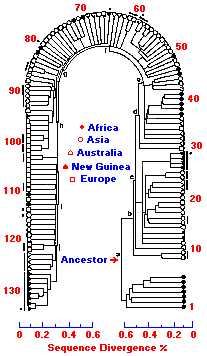 --- mtDNA and Human Evolution --- |
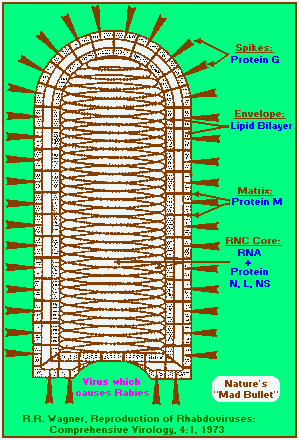
--- Viral Diseases --- |
mtDNA and Human Evolution URL: http://artsci.wustl.edu/~landc/html/cann/
Viral Diseases URL: http://www.kcom.edu/faculty/chamberlain/Website/Lects/VIRAL.HTM
While most of us can easily recognize the "flower arch" as a sampling of biological life forms that respond to solar activity in a manner that is commonly referred to as a Circadian clock, the idea that the "mitochondrial DNA arch" (or "arch-like" rabies virus) are also representative of different types of Circadian clocks, may not be easily understood without first being introduced to a refresher course of the Circadian clock idea with respect to biological rhythms.
Herb O. Buckland
herbobuckland@hotmail.com